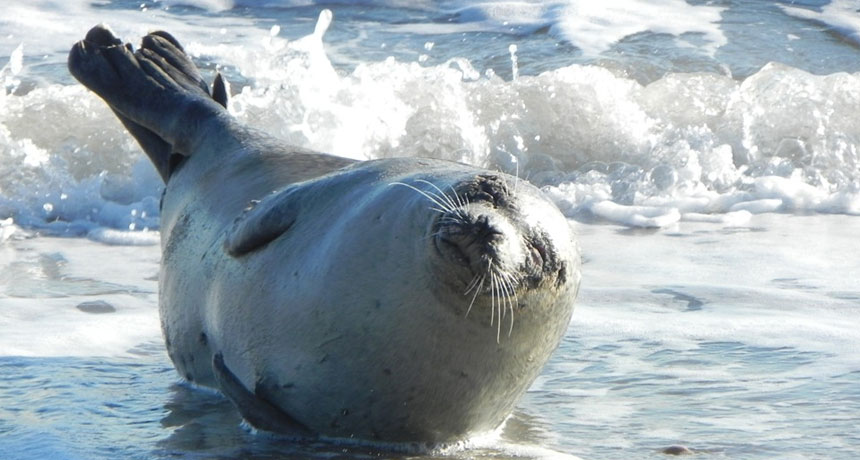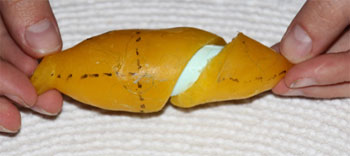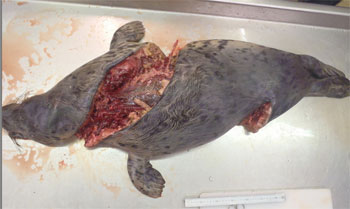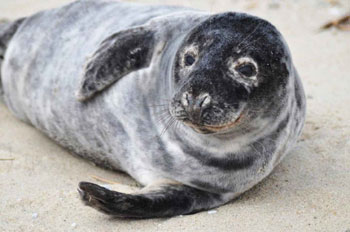Seals: Catching a ‘corkscrew’ killer
Source of strange spiral wounds — another seal — surprises marine mammal experts

Scientists have found numerous harbor seals, like this one, that have been targeted by an unexpected source.
U.S. National Park Service
By Liz Devitt
SAN FRANCISCO, Calif. — For seven years, scientists in Scotland puzzled over peculiar wounds found on more than 100 dead seals. A single, clean cut spiraled around each seal’s body. Strikes from ship propellers usually leave deep, parallel lines. Shark bites make jagged tears. And the neat, spiral wounds couldn’t have come from another animal. At least, that’s what everyone had thought. Until now. New video shows the seal killer is indeed alive — and another marine mammal.
A cluster of these corkscrew cases were found on the Isle of May, off the east coast of Scotland. That’s not far from where a small colony of harbor seals (Phoca vitulina) make their home in the Firth of Tay. A decade ago, more than 600 harbor seals lived in this inlet north of Edinburgh. Since then, their population has dwindled to fewer than 30.
Most of the harbor-seal victims with corkscrew cuts were females. That made this pattern of injuries even more worrisome: A small colony can’t afford to lose many breeding females.

So scientists from the Sea Mammal Research Unit at the University of St. Andrews in Scotland investigated. Their first hypothesis was that the spiral wounds had been caused when boat propellers hit the seals. To test this idea, they built models of different types of propellers. Then they pushed seal “dummies” into the spinning blades. Those experiments showed that one kind of propeller created wounds similar to those on the dead seals. And with that, the case seemed closed.
Still, no one understood why seals would swim into the propellers. Maybe the spinning blades’ noise made them curious, and they got too close?
An answer was important for the seals and for the boating industry. These special propellers were becoming more popular because they helped boats use less fuel. If studies showed the propellers killed seals, then a costly design change might be needed.
Before anyone figured out what might have attracted seals to the propellers, however, another culprit showed up on camera. This “video bomb” happened while a marine biologist was recording gray seals (Halichoerus grypus) at their breeding colony on the Isle of May.
Caught on camera
In the background of this video, an adult gray seal killed and ate a gray-seal pup. Its wounds appeared as a deep spiral cut.
Andrew Brownlow examined nine dead pups found in the same area. He directs the Scottish Marine Animal Stranding Scheme at Scotland’s Rural College in Inverness. As a veterinary pathologist, he studies marine animals that wash ashore — such as seals, whales and porpoises — to understand what caused their deaths.The wounds on each harbor-seal pup looked just like injuries that had been described as propeller trauma in previous reports.

Over the years, similar wounds have been reported on dead seals found in other countries. In Canada, experts thought sharks caused the injuries. In two other instances, off the coast of Germany, a gray seal was seen attacking harbor seals.
The recent video of the seal attack was the “single most significant finding which led to us changing our ideas as to the likely cause of these lesions,” says Brownlow. “Prior to this, we considered it rare behavior if gray seals ate other seals. We also did not think that it was possible for bite and tear attacks to cause such smooth-edged wound margins.”
With the new information, Brownlow went back over the old records for 46 “corkscrew” seals. More than 80 percent of the seals listed as trauma cases had wounds that he now couldn’t tell apart from those caused by the gray seal attack. Before the attack caught on video, that type of trauma was thought to be from scavengers. Scientists assumed animals had been feeding on the seals after they had died from other causes. Now, both the wounds and the deaths appeared likely to come from attacks by gray seals.
Andrew Brownlow shared his team’s findings, here, at the Society for Marine Mammalogy meeting in San Francisco, Calif., on December 16.

“It may be that there are more gray seals,” says Brownlow, so it’s easier to see that the gray seals are eating animals other than fish.
Case not closed
Still, no one is ready to say the corkscrew case is fully solved.
Marine mammal specialists in Scotland will continue to collect reports of seals with corkscrew injuries. After the eyewitness attack, the gray seal from the Isle of May was tagged with a tracking device. That seal has since travelled to and from northeastern Germany. It’s another place where gray seal attacks on other seals have been recorded.
“This shift in specialized predation is still fairly rare,” says Philip Hammond. He’s a population biologist. He also works at the Sea Mammal Research Unit at St. Andrews University. But he was not involved in studying the corkscrew cases. For him, it’s still unclear how big a source of pup deaths the gray seals are. “Propellers,” he worries, “haven’t been completely ruled out.”
Power Words
(for more about Power Words, click here)
breed (noun) Animals within the same species that are so genetically similar that they produce reliable and characteristic traits. German shepherds and dachshunds, for instance, are examples of dog breeds. (verb) To produce offspring through reproduction.
DNA (short for deoxyribonucleic acid) A long, double-stranded and spiral-shaped molecule inside most living cells that carries genetic instructions. It is built on a backbone of phosphorus, oxygen, and carbon atoms.In all living things, from plants and animals to microbes, these instructions tell cells which molecules to make.
hypothesis A proposed explanation for a phenomenon. In science, a hypothesis is an idea that must be rigorously tested before it is accepted or rejected.
mammal A warm-blooded animal distinguished by the possession of hair or fur, the secretion of milk by females for feeding the young, and (typically) the bearing of live young.
marine Having to do with the ocean world or environment.
marine biology The field of science that deals with studying creatures that live in ocean water, from bacteria and shellfish to kelp and whales. A person who works in this field is called a marine biologist.
pathologist Someone who studies disease and how it affects people or other infected organisms.
population (in biology) A group of individuals from the same species that lives in the same area.
population biologist Someone who studies groups of individuals in the same species and the same area.
predation A term used in biology and ecology to describe a biological interaction where one organism (the predator) hunts and kills another (the prey) for food.
scavenger A creature that feeds on dead or dying organic matter in its environment. Scavengers include vultures, raccoons, dung beetles and some types of flies.
shark A type of predatory fish that has survived in one form or another for hundreds of millions of years. Cartilage, not bone, gives its body structure.
tagging (in biology) Attaching some rugged band or package of instruments onto an animal. Sometimes the tag is used to give each individual a unique identification number. Once attached to the leg, ear or other part of the body of a critter, it can effectively become the animal’s “name.” In some instances, a tag can collect information from the environment around the animal as well. This helps scientists understand both the environment and the animal’s role within it.
trauma (adj. traumatic) Serious injury or damage to an individual’s body or mind.
veterinarian A doctor who studies or treats animals (not humans).
veterinary Having to do with animal medicine or health care.







